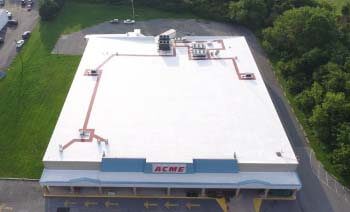When selecting a roofing system, many assume that white roofs are better than black roofs due to their energy-saving potential. While this belief has led some city councils to favor white roof systems in their model codes, the reality is more complex. There are several factors to consider when choosing between a white and black roof, including climate, building usage, and maintenance requirements.
In this post, we will debunk three common myths about white roofs and offer key considerations for selecting the right roofing solution for your commercial or industrial building.
Myth 1: White Roofs Are Ideal for All Locations
False. A white roof coating may not be the best choice for every location. The efficiency of a white roof depends largely on your local climate and the balance between heating and cooling needs. For example, in the Northeast, where there are many more heating days than cooling days, a black roof may be more effective in retaining heat and reducing energy costs.
Additionally, snow and ice tend to linger longer on white roofs, which can pose safety risks for maintenance crews who need to clear the roof. In high-snow regions, this can make the roof surface more dangerous for workers.
Key Takeaway: It’s important to assess both the climate and your building’s specific operational needs before deciding on a black roof vs. a white roof.
Myth 2: White Roofs Reduce Global Warming and Mitigate Urban Heat Islands
False. While white roofs do reflect heat and can help reduce a building’s cooling needs, they are not necessarily a global warming solution. A study from Stanford University found that white roofs may contribute to warming at a global scale by reflecting heat into the atmosphere, where it interacts with airborne particles and can increase temperatures.
Therefore, while a white roof might help cool your building, it won’t necessarily have the intended environmental impact. Consider additional energy-saving strategies (such as improving insulation or choosing energy-efficient materials) to make a bigger difference.
Key Takeaway: While white roofs can offer energy benefits, they are not a cure-all for environmental issues like global warming or urban heat islands.
Myth 3: White Roofs Stay Clean and Reflective
False. White roofs are prone to collecting dirt, which can diminish their reflective properties over time. Without regular maintenance and cleaning, a white roof can lose its energy-saving advantages. Dirt, debris, and pollution buildup make the roof appear dull, reducing its effectiveness in keeping the building cool.
Routine maintenance, including power washing, is necessary to keep a white roof performing well. This can add to the long-term costs of owning a white roof, and commercial property owners should factor this into their decision.
Key Takeaway: Maintenance is essential for keeping white roofs clean and effective. If you are not prepared for regular upkeep, the energy benefits of a white roof may diminish over time.
Key Considerations: White vs. Black Roofs
Selecting the right roof for your building involves more than just color. Here are some important factors to consider when deciding which roofing system best meets your facility’s needs:
- Building usage: Does your facility require more heating or cooling? The building’s function often dictates what type of roof is most energy-efficient.
- Location and climate: How does your local climate affect the performance of different roofing materials? In colder areas, black roofs may help reduce heating costs, while white roofs are more effective in hot, sunny environments.
- Occupancy and foot traffic: High-traffic areas or frequently accessed roofs may benefit from more durable materials. Consider how often maintenance crews or workers need to be on the roof.
- Life cycle costs: What are the upfront costs versus long-term maintenance costs? Some roofing systems may be more expensive initially but save you money over time with fewer repairs.
- Building codes and regulations: Are there local building codes or energy standards that influence your roofing choice? Compliance can often provide energy savings and other benefits.
- Sustainability goals: Do you have sustainability targets to meet? Insulation, energy-efficient materials, and the building’s overall design can help you achieve them more effectively than roof color alone. Learn more about commercial green roof systems.
GSM Roofing: Helping You Make the Right Roofing Decision
At GSM Roofing, we’ve been guiding facility managers and property owners through the complexities of roofing choices for over 77 years. We understand that each building is unique, and energy efficiency is just one piece of the puzzle. Our team of experienced professionals considers your building’s usage, location, and specific requirements before recommending the best roofing system for you.
Whether you need a new roof or advice on maintaining your existing one, we’re here to help. Contact us today

